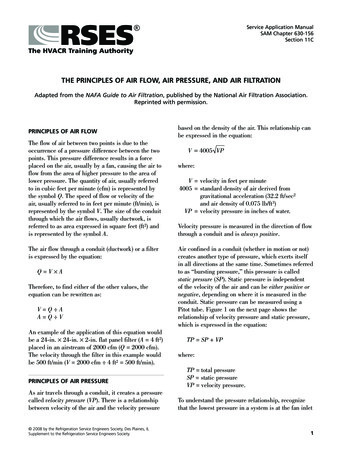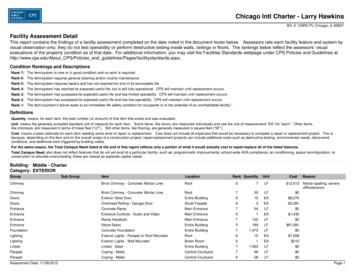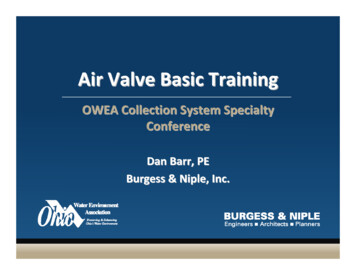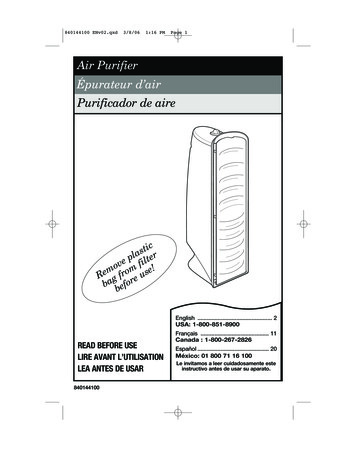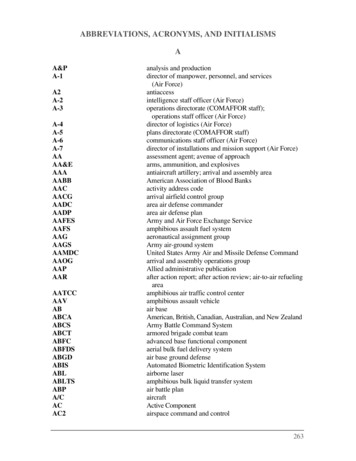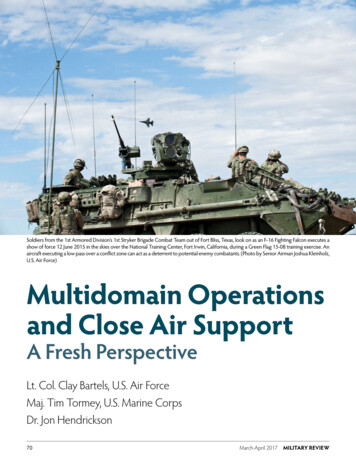
Transcription
Soldiers from the 1st Armored Division’s 1st Stryker Brigade Combat Team out of Fort Bliss, Texas, look on as an F-16 Fighting Falcon executes ashow of force 12 June 2015 in the skies over the National Training Center, Fort Irwin, California, during a Green Flag 15-08 training exercise. Anaircraft executing a low pass over a conflict zone can act as a deterrent to potential enemy combatants. (Photo by Senior Airman Joshua Kleinholz,U.S. Air Force)Multidomain Operationsand Close Air SupportA Fresh PerspectiveLt. Col. Clay Bartels, U.S. Air ForceMaj. Tim Tormey, U.S. Marine CorpsDr. Jon Hendrickson70March-April 2017MILITARY REVIEW
CLOSE AIR SUPPORTTightening budgets have reignited long-simmeringdebates on the roles and missions of airpower.The Air Force remains persistent in its recommendation to retire the A-10 aircraft (sometimes calledthe Warthog). Though there are developmental issueswith the A-10’s notional replacement, Lockheed-Martin’sF-35, mounting fiscal pressures keep the Air Force fromchanging its plans. As a result, some have even proposedthat the Army procure and operate its own fixed-wingground attack aircraft.1 In the increasingly complex andcontested future operating environment, the optimalwarfighting approach for the American military mustbe centered on multidomain operations. Any parochial service decision would be dangerous and foolhardy.Examining close air support (CAS) in conjunction withother overlapping missions that occur in the intersectionof the land and air domains effectively demonstrates thenecessity of multidomain operations. Further, multidomain thinking in the CAS arena allows the U.S. military to better understand how to maximize the flexibilityand capability airpower provides when applying multirole platforms such as the F-35.Since the codification of the joint force with theGoldwater-Nichols Act in 1986, the United States usesthe combined joint task force (CJTF) structure withcoalition partners to conduct warfare. This constructand underlying doctrine were first employed duringOperation Desert Storm in 1991. However, the Armyoften sees itself as theLt. Col. Clay Bartels,force that exists to win theU.S. Air Force, is annation’s wars and seeksF-22 pilot assigned to theself-reliance as a service2Air Command and Staffcapability. In reality, aCollege as an academic inCJTF conducts operationsstructor and advisor in thereporting to a geographicDepartment of Leadership.combatant commander (aBartels is a graduate of thejoint billet) who reports toUnited States Air Forcethe president and secre3Academy. He holds an MAtary of defense. No serfrom the Air Commandvice fights alone, yet eachand Staff College. He hasoften thinks and planscompleted squadronindividually. This probcommand and has hadlem of insular planningnumerous operationaloccurred repeatedly in thedeployments in the Unitedtwentieth century, in opStates Central Commanderations from Guadalcanal4area of responsibility.to Vietnam.MILITARY REVIEWMarch-April 2017Behind this insulated thinking is a lack of trust thatthe Air Force will be present to support the groundscheme of maneuver. This fear highlights an important concern but lacks supporting empirical evidence.Transferring to the Army a single-mission platformsuch as the A-10 or incorporating a fiscally responsibleexisting solution like the Beechcraft AT-6 to support thedoctrinally defined roles of our services only furthersservice stovepiping.5 This arrangement will not defeatthe next adversary, particularly in the current andprojected fiscally constrained and contested operatingenvironment. In order to achieve the required levelof service cooperation demanded by a multidomainapproach, the foundation must be mutual trust. Thefirst step toward achieving increased trust is a commonunderstanding of multidomain operations.The Multidomain Approachto WarfightingSince the passage of the Goldwater-Nichols Act,joint operational approaches have proven themselvesin combat. For the most part, Goldwater-Nichols hasachieved many of its objectives. However, work remains, especially when considering the rapidly changing global operational environment. Further, the jointtask force doctrinal structure used over the past fifteenyears to promote joint capability has actually drivenhome incorrect habits of mind that are detrimental inthe evolving operational environment. In particular,these habits drive theMaj. Tim Tormey,service components toU.S. Marine Corps, isthink about their rean MV-22 pilot assignedspective operating areasas an exchange instructoras if in a vacuum. Theseat the Air Command andconcerns reportedly ledStaff College, Departmentof Joint Warfighting. Heis a United States NavalAcademy graduate andholds an MA from theMarine Command andStaff College. He has hadseveral Marine expeditionary unit deployments andhas gained significant experience in assault supportintegration.Dr. Jon Hendrickson is aprofessor of security studies at the Air Commandand Staff College. Heholds a PhD in militaryhistory from Ohio StateUniversity, and he haspublished works on navalhistory of the late nineteenth and early twentiethcenturies.71
then Chairman of theJoint Chiefs of StaffGen. Martin Dempseyto ask in November2011 what would comeLandafter joint, initiating adiscussion that continues to this day.6 WhatCyberAircomes next is the bestjoint force solution tothis problem: a multiMaritimedomain approach.7The essence ofmultidomain operationsis to think about milSpaceitary problem solvingin a nonlinear way andto conduct operationsfocused on achievingobjectives rather than(Graphic by Maj. Tim Tormey)on maintaining disFigure 1. Multidomain Concepttinct component lanes.Traditional thinking thatrigidly aligns domains and components (land with thecontinue, the American military is attempting toArmy, maritime with the Navy, and air with the Airdisaggregate command and control and push decisionForce) will not be effective in the future. The complexitymaking to the lowest level possible due to the requireof current and future operations requires breaking thisment for a much faster decision cycle.8 Because of this,a multidomain approach must be used.pattern of thought in order to more seamlessly integrateA historical example from World War II illusthe unique capabilities of each component to create theeffects required to meet tactical, operational, and strategic trates the importance of multidomain operations. On7 August 1942, American forces landed on the Pacific isobjectives. Multidomain operations will also allow U.S.land of Guadalcanal in the Solomon Islands chain. Aftermilitary forces to leverage the potential of new, emergingthey established control over the island’s airfield, whichdomains, such as space and cyber. These domains arethey christened Henderson Airfield, the focus of the camintegral to modern warfighting, yet there is no cyber forcepaign shifted from preventing or forcing a landing on thecomponent commander in charge of “cyber” at the jointisland to sustaining and reinforcing the U.S. forces alreadytask force level, where we primarily conduct major milon Guadalcanal. Both major bases in the area—Rabaulitary operations. The component lens is not sufficient infor Japan, and Espiritu Santo for the United States—werethis environment because operations are too complex.about 560 miles from the island. While this may seemMultidomain operations strive to achieve unity oflike a battle fought in the maritime domain, both sidescommand or unity of effort through conceptual unityused a variety of multidomain efforts to try to force andof thought. Operations occurring in the land domainkeep open the access routes to Guadalcanal.must consider effects in and through the air, maritime,For the Americans, these operations focused oncyber, and space domains, and vice versa (see figure 1).This noncomponent way of thinking minimizes friend- stopping the Japanese convoys ferrying troops andsupplies from Rabaul to Guadalcanal. Air operationsly vulnerabilities and provides an effective way to findfrom Henderson Airfield entered the maritime domain,adversary vulnerabilities for exploitation in and frommultiple domains. As efforts to counter U.S. advantages forcing Japanese transports to move at night within the72March-April 2017MILITARY REVIEW
CLOSE AIR SUPPORTAmerican air umbrella, which made navigation and cargohandling more difficult. Air forces also supported effortsin the land domain to expand and protect the HendersonAirfield perimeter from Japanese attacks. American navalforces crossed into the land domain, offering naval gunfiresupport to land forces, harassing Japanese land forces withbombardments, and interdicting supplies as they movedto, and around, the island of Guadalcanal. Naval forcesalso entered the air domain by using carrier-based aircraftto attack Japanese aircraft carriers intent on raidingHenderson Airfield, as well as interdicting Japanese efforts to bombard the island by sea. Land forces influencedthe maritime fight through coast watchers who providedintelligence on Japanese movements by sea and air, asdomain by bombarding Henderson Airfield from thesea. Japanese land forces made several attempts to closeHenderson Airfield by assault, which would have giventhe Japanese control of the air over the island to allowmovement of supplies by sea. In the end, the ability ofU.S. and Allied forces to coordinate their multidomainactivities allowed them to enjoy the synergistic benefits of working across domains. The Japanese were lesssuccessful in their ability to bring land, air, and seatogether into a cohesive operation, and they eventuallylost Guadalcanal and other islands as a result.9Maximizing Airpower Effectsin the Land DomainWithin the broader contextof multidomain operations,analyzing airpower effects in theFiresland domain illustrates the valueClose airof contemporary force employsupportment that has evolved beyondIntelligence,surveillance, andjoint constructs. The intersecreconnaissance Commandtion of the air and land domainsand controlencompasses a myriad of misSustainmentsion sets, to include air mobility;Airspace; cyber; personnel recovoperationsMovementcenterery; fires; intelligence, surveiland maneuverlance, and reconnaissance (ISR);Air supportand many others (see figure 2).AiroperationsinterdictioncenterThe CAS mission primarily fallsunder the joint function of firesPersonneland is just one small piece of therecoverybroader picture that includesprotection, command and control, movement and maneuver,(Graphic by Maj. Tim Tormey)intelligence, and sustainment.10Figure 2. Air/Land Domain IntersectionEstablishing air superiorityis the first and most importanteffect that airpower provides for the land domain andwell as providing security to Henderson Airfield fromoverall joint force. Contemporary airpower theorist PhilJapanese land attack and artillery bombardment.The Japanese did not miss out on multidomain oppor- Meilinger writes, “whoever controls the air generallycontrols the surface.”11 In a more nuanced version of thetunities either. Japanese air forces in Rabaul threatenedsame thought, Colin Gray posits, “control of the air is theAmerican ships at sea, limiting the areas in which thefundamental enabler for all of airpower’s many contriU.S. Navy could operate safely. They also raided U.S. landpositions on the island. Japanese naval forces supported butions to strategic effect.”12 U.S. forces are accustomedto having unfettered access to the air, but potential adland operations by escorting transports to the islandversaries are becoming capable of creating an environand by sinking several American ships that attemptment where the joint force will not have uncontesteded to blockade the island. They intruded into the airLandMILITARY REVIEWAirMarch-April 201773
freedom of maneuver.13 Furthermore, active oppositionto and increased competition against force projectioncapabilities are occurring.14 An acceptable level of airdomain control is a prerequisite to enable the groundscheme of maneuver.Once access to the land domain is achieved, precisionfires are an essential element for achieving a joint forcecommander’s maneuver objectives. Joint airpower assetshave the capability to directly attack an enemy’s centerof gravity.15 No matter the operational or strategic natureof a center of gravity, airpower can affect it because ofairpower’s inherent flexibility. If the center of gravity isenemy leadership, it can be attacked through strategicstrike. If the center of gravity is an enemy naval taskforce, airpower can combine with naval assets, such assurface ships and submarines, to destroy it. If the centerof gravity is an enemy land formation, air and land assetscan work to destroy it. In addition, air power’s flexibilitymakes it easier to attack soft targets to achieve follow-oneffects in other domains, such as attacking enemy command-and-control facilities to hamper enemy coordination against maneuvers by land and sea forces.Operation Anaconda, which occurred in March 2002in Afghanistan, illustrates the advantage of applying74An F-35A Lightning II joint strike fighter completes the first in-flightlaunch of an AIM-120 missile 5 June 2013 over the U.S. Navy’s PointMugu Sea Range near Oxnard, California. (Photo courtesy of the F-35Program Office)multidomain thought (or the disadvantage of not applying it), particularly in terms of operational planning.The ground commander, Army Maj. Gen. Franklin L.Hagenbeck, paid insufficient attention to air planning tosuch an extent that the combined force air componentcommander and the combined air operations centerwere not involved in the planning process at all; theyonly became aware of the impending operation whenthe operation order was issued on 20 February.16 TheTaliban provided much more resistance than expected, and a pitched battle occurred with a furious andurgent call for CAS. The major CAS effort began slowly.However as the battle progressed, CAS rapidly improved and ultimately became the “key to winning thebattle.”17 Had the planners in Anaconda leveraged a multidomain perspective, effects from other domains couldhave been integrated from the very start of the operation. Even if their planning resulted in a ground-centricMarch-April 2017MILITARY REVIEW
CLOSE AIR SUPPORToperation, a multidomain thought process could haveensured the other components were engaged.In addition to fires, other emerging mission areasshould also be considered an integral part of operations toachieve effects in the land domain. Remotely piloted aircraft that provide persistent full-motion video can deliveror direct effective battlefield fires. Airborne ISR and mobility also closely integrate operations in the air domainfor effects on the surface; these areas more accurately fallunder CAS when considering the word “support.”Thus, an understanding of operations and the synergycreated by the land and air domains needs to expand.Airpower is inherently flexible. In order to maximizeeffects from the air on the land domain, multirole aircraftsuch as the F-35 are necessary. As an operating environment becomes increasingly contested and degraded,survivable platforms must be employed across the spectrum, from the low-intensity CAS mission to global strike.Basing our force structure solely on the current threatenvironment would be a mistake because the UnitedStates must have capabilities beyond those effective onlyin a permissive environment. The flexibility of airpoweris a true force multiplier in multidomain operations—amust-have for the U.S. joint force.Understanding Joint Fires andClose Air SupportThe first hurdle toward understanding the roleof CAS in multidomain operations is agreeing on anadequate definition of CAS. All involved, from theinfantryman to the airman, must arrive at a corporate definition so CAS is common language and notan ambiguous concept. Joint doctrine defines CASas “an air action by manned or unmanned fixedwing and rotary-wing aircraft against hostile targetsthat are in close proximity to friendly forces andthat require detailed integration of each air missionwith the fire and movement of those forces.”18 Underthe air-land domain integration umbrella, DerekO’Malley and Andrew Hill recommend five CAScharacteristics: CAS should be close so it can be persistent, precise and rapid so it can kill enemies andavoid fratricide, versatile so it can operate in variouscontexts, scalable so it can use the right amount offirepower for the situation, and integrated with landforces so the air forces can promptly share usefulinformation with the warfighters on the ground.19MILITARY REVIEWMarch-April 2017To achieve a common understanding, a culturalparadigm shift is necessary. Specifically, the land component’s thinking and associated lexicon regarding CASneed adjustment. The traditional Army view of CAShas morphed from a maneuver support function to “aircover as a preventive measure with the expectation ofenemy contact,” according to Mike Benitez.20 In “HowAfghanistan Distorted Close Air Support and Why itMatters,” he describes how this view of CAS emerged“after years of fighting asymmetric, low-intensity, guerrilla warfare.”21 CAS as viewed through this protectionlens is narrow. CAS should instead be viewed from thefires perspective and not under the protection categoryof the joint functions. Hostile targets in close proximityto friendly forces have been and will continue to be theexception to the most efficient use of aviation-deliveredfires. While airplanes overhead provide a psychologicalsafety net in the event of a miscalculation on the battlefield, the same can be said of any type of precision firesavailable organically to the land force. Changing this paradigm overcomes a cultural barrier, opening the apertureand allowing alternative, effective, and safe fires.In this paradigm, the first priority for the groundcomponent is organic to the Army. It includes precision-guided artillery fire, rotary-wing CAS, and evenGPS-guided mortars. Nonorganic fires can come from anarray of current Air Force or Navy delivery vehicles (e.g.,A-10, AC-130W, B-1, B-52, F-15E, F-16 Block 40/50,F-18, F-22, MQ-1, MQ-9, and F-35), many of which haveall the desirable attributes of a CAS platform. These typesof fires all provide the desired result and do so with theprecision required in dangerous close environments.A consistent impediment to effective multidomainoperations and joint fires has been coordination of responsibility and authority. The early phases of OperationIraqi Freedom clearly demonstrate several doctrinal flawsthat a capable adversary could exploit. The fundamental problem was that the speed and complexity of thesituation outpaced the capability of the coalition forces toeffectively command, control, and integrate air and landdomain forces. Doctrinally, deconfliction of responsibilityfor fires is accomplished by various fire support coordination measures in specific areas of operation, usuallycontrolled by the joint force land component commander.22 In Operation Iraqi Freedom, the joint force land component commander delegated fire support coordinationline authority to the Army’s V Corps, which would often75
place the fire support coordination line up to one hundredkilometers from the forward edge of troops.23 In 2003, thisdefinition of the “deep” area forced the combined force aircomponent commander and the 3rd Infantry Division(Mechanized) [3ID(M)] into a cumbersome coordination process that often shut down both surface and airpower fires.24 The division’s after action report states, “theargument seems to be that CFACC [the combined forceair component commander] would not adequately address V Corps targeting requirements; 3ID(M) violentlydisagrees 3ID(M) believes CFACC is better preparedto engage targets to effectively shape the battlefield.”25The lesson in Operation Iraqi Freedom’s “race toBaghdad” is not whether the land component or the aircomponent should have had higher authority in delineating targets. Instead, the joint force needs to address thecause of these operational seams to ensure a future adversary does not exploit them. In spite of the implementationof the joint air component coordination element after thelessons of Operation Anaconda, air-ground integrationstill has room to improve.26 The multidomain conceptprovides a helpful lens toward achieving an increasingly integrated and highly agile approach to warfighting.Maneuver in the land domain and maneuver in the airdomain should be viewed as equal partners and mutuallyenabling functions. As a starting point, the term CAS bydefinition is misleading because it implies a relationshipdominated by the ground force.27 RAND proposes theterm “close air attack” as a more accurate way to communicate the partnership between air and ground forces.28Trust is fundamental to ensuring this relationship is functional and multidomain thought is institutionalized.In addition to a habit of thought, a more flexible firesupport coordination command-and-control structureis also needed. Using the principles of mission command, operational agility and integration are increasedby pushing decision making down to the lowest level.The Marine Corps already uses a concept that delineates an area between CAS and the fire supportcoordination line and the battlefield coordination line,for the purpose of allowing Marine air-ground taskforce aviation to “attack surface targets without approval of a GCE [ground combat element] commander, inwhose area the targets may be located.”29 The battlefieldcoordination line provides an intermediary coordination measure between CAS and deep operations, whichallows better exploitation of targets and integration of76air and land power. Another solution is to keep the firesupport coordination line as close to the forward line oftroops as possible. Flexibility in command and controlwill require changes from both the air and land components to match the current operational context. Finally,battlefield decision making below the component levelis required to successfully operate in a contested anddegraded air and land environment, especially if airdomain superiority falls somewhere on the continuumbetween localized air superiority and air parity.30 Thejoint air operations center, a monolith of centralizedcontrol, must delegate decision making and authorityto a lower level tightly integrated with land domainoperations.31 A coordinated, domain-focused command-and-control architecture will greatly improvejoint force decision making and enable the level ofoperational agility future threats require.Furthermore, recent operations provide opportunitiesto more accurately define CAS. If close air attack is usedas a more precise term, then the joint force can beginto view this mission as integrated, domain-based fires.Traditional CAS synchronizes ground and air element resources for a ground-based objective—exactly the way organic Army aviation integrates with its ground forces—inclose proximity to and with a regular working relationshipthat permits increased levels of both situational awarenessand effectiveness. However, other missions outside thetraditional definition of “danger close” have been conducted under the CAS umbrella, usually because a jointterminal attack controller (JTAC) is clearing the fires.The trend from Kosovo to Operation Enduring Freedommoves away from traditional infantry and armor airsupport, to a special-operations-forces-heavy integrationwith precision air that is “far different from traditionalnotions of CAS, a novel concept that touched the heartof the always sensitive special operations forces—conventional Army relationship.”32 Today, in Operation InherentResolve, aircraft are executing these close air attackmissions while the JTAC and ground commander arefar from the coordinated fires. They can do so effectivelybecause of technology such as satellite radio, full-motionvideo, and video downlink. The same precision necessaryin CAS is necessary in prosecuting these low-collateraldamage, high-value targets.Thus, our understanding of the doctrinal term CASneeds to expand. Close air attack fires have moved pastwell-understood concepts first developed in the worldMarch-April 2017MILITARY REVIEW
CLOSE AIR SUPPORTwars, and comprehending this shift is essential to multidomainoperations. CAS is truly platform immaterial. The most appropriate delivery vehicle should vary based on specific missionparameters and the operational and tactical situation. A widevariety of platform options has the required level of persistenceand precision to achieve the desired effects on the battlefield.Applying multidomain thought also illuminates friction areasin coordinating fires using the fire support coordination linefor the deep and close ground schemes of maneuver. In orderto ensure this does not continue, both the Army and the AirForce need to increase the agility of their respective command-and-control systems to delegate decision making to alower level. Examining the Air Force specifically and the CASmission provides deeper understanding of the integration between the land and air domains.A DIFFERENTVIEWPOINTA Closer Look at Air ForceClose Air SupportCAS, under any definition, is much more than a platform.The hardware component is a small portion of the overallinvestment the Air Force has made in championing today’sCAS fight. To determine the level to which the Air Force hasdemonstrated its commitment to CAS, any evaluation mustanalyze three essential elements, with no special considerationgiven to platform. First, one must consider the emphasis andresources dedicated to training. Second, one must look closelyat doctrine and ideas. Finally, one must examine operationalexamples that show the commitment of the Air Force to CASas seen in contemporary operations.Certainly, the largest investment in CAS comes in the training realm, both for the pilot and the weapons controller on theground calling in the strike. The controller is the final clearinghouse for weapons release and is in possession of the clearest picture of friendly positions in relation to the enemy. Both combatcontroller and tactical air control party airmen graduate fromthe Special Tactical Training Squadron (STTS) at Hurlburt Field,Florida. In 2007, the STTS graduated roughly forty students, andthat number has now more than tripled to its current annualthroughput of 144 students.33 Today’s students will also earntheir advanced JTAC certification from the Special OperationsTerminal Attack Controller Course in Yuma, Arizona. In 2009,the Air Force purchased the Special Operations Terminal AttackController Course facility from the United States Army SpecialOperations Command and now also trains all Army JTACs.The Special Operations Wing at Hurlburt funds that trainingin Yuma at about 4 million per year to cover the CAS assetsrequired to certify each JTAC.34MILITARY REVIEWMarch-April 2017Maj. John Q. Bolton offers a differentpoint of view on close air support in“Precedent and Rationale for an Army FixedWing Ground Attack Aircraft.” The Army aviator argues that the U.S. Air Force considersclose air support a high-risk, low-payoff mission, and the Army needs to take over this mission with its own organic fixed-wing aircraft.For online access to Bolton’s “Precedent andRationale for an Army Fixed-Wing GroundAttack Aircraft” in the May-June 2016 issueof Military Review, visit: s/English/MilitaryReview 20160630 art014.pdf.77
Does this institutional investment provide whatthe average infantrymen need when they call for CAS?Arguably, they “want,” from either experience or legend,the A-10 screaming in low with its seven-barrel, 30-mmGatling gun roaring and its large payload wreaking havocand destruction on the battlefield. The psychological effecton the enemy observing this cannot be discounted. But ifprecisely killing the enemy while avoiding fratricide is therequired effect, then the platform delivering the effect isirrelevant. The F-35 is indeed capable in the CAS mission area, and it will have improved capacity over time.However, while the F-35 is conducting a deeper strike at acritical enemy center of gravity, the Air Force has numerous other platforms that will deliver the desired outcomes.The B-1 Lancer is just one of those CAS-capableplatforms that carries the largest payload of any guidedor unguided weapon in the entire Air Force inventory.35The B-1 can carry an assortment of GPS and laser-guided five hundred- and two thousand-pound bombs andin quantities every JTAC desires. In a show of Air Forcecommitment to the CAS mission, a 2009 account ofsoldiers pinned down at Outpost Keating in Nuristan,Afghanistan, clearly demonstrates this reality. “Bone 21,”the call sign of the B-1, was diverted from routine patrolling to Outpost Keating, 1,300 miles from its base oforigination in Qatar. With a limited understanding of thegravity of the situation on the ground at Outpost Keating,Air Force controllers redirected “Bone 21” at supersonicspeeds, to provide plentiful danger close fires to the soldiers in dire threat of being overrun by an estimated threehundred Taliban fighters.36 This is one of many examplesof the level of Air Force commitment to the infantryman.The Air Force is fully committed to and invested in theCAS mission in support of the joint warfighting environment. The Air Force has institutionalized the battlefieldairman and the JTAC construct, which will not go away.37Gen. Larry Welch, the previous Air Force chief of staff,pointed out in 2016 that over the last seven years, the AirForce flew on average twenty thousand CAS sorties a year,providing a needed function to the joint combatant commander.38 Gen. Herbert Carlisle, air combat commander,recently stated, “We are using almost every platform wehave to do CAS.”39 Senior leader statements and organizational decisions by the Air Force cle
they christened Henderson Airfield, the focus of the cam-paign shifted from preventing or forcing a landing on the island to sustaining and reinforcing the U.S. forces already on Guadalcanal. Both major bases in the area—Rabaul for Japan, and Espiritu Santo for the United States—were about 560 miles from the island. While this may seem




